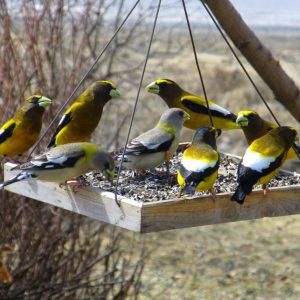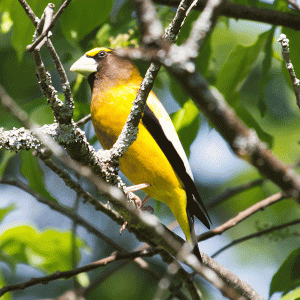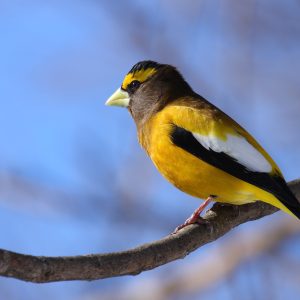
Back in the 1970s, bird-feeding enthusiasts everywhere seemed to talk about buying a hundred pounds of sunflower seed every few weeks to feed Evening Grosbeak flocks of fifty or hundred, or even more, that arrived daily to their backyard feeders in the winter. The species has since declined by 92%. (photo courtesy of Bill Sheehan)
When we think of Evening Grosbeaks, we remember the hordes of them gorging themselves at the double-decker platform feeder at a former family home in Winthrop. We’d watch from the large living room window as the plump golden, black, and white orbs chomped through gobs of sunflower seeds with their enormous bills. Sometimes the flocks were so plentiful that we spread seed several times a day, as the birds apparently knew they had discovered a treasure trove.
We weren’t the only ones enjoying bounty of Evening Grosbeak house guests. Back in the 1970s, bird-feeding enthusiasts everywhere seemed to talk about buying a hundred pounds of sunflower seed every few weeks to feed flocks of fifty or hundred, or even more, that arrived daily to their backyard feeders in the winter.
And then they were gone…

This year a southward irruptive movement of Evening Grosbeaks is being documented across much of the U.S. (photo by David Small)
Now, we birders consider ourselves lucky when we see even a couple of them at a feeder or hear some flying overhead once or twice a season. Sure, there are some places up north where people are graced with small flocks in the winter, and the species does breed in a few locations in northern Maine. But since the 70s, Evening Grosbeak populations have declined by 92%. Researchers have yet to determine the reasons for this population crash, but it’s no wonder observations of Evening Grosbeaks are scant these days. We remember one year circling around the vicinity of the State House, where a few had been reported—and hoping they might make an appearance at the Natural Resources Council of Maine—but to no avail.
So we’ve been excited to see that this year, there’s already been a southward irruptive movement of Evening Grosbeaks documented across much of the U.S. Through eBird, we can see that birders as far south as the Outer Banks of North Carolina as well as in Virginia, Kentucky, southern Illinois, and southern Missouri documented Evening Grosbeaks in October and into November. Evening Grosbeaks have also been found at one the country’s birding meccas—Cape May, New Jersey—and around Washington, D.C., over the last few weeks.
Here in Maine, there have been many reports of Evening Grosbeaks. Some were seen at feeders where lucky birders have had the chance to photograph them. Others have been flying high overhead, faintly heard as they passed south. We’ve count ourselves fortunate to have recently heard a couple flying over high above in the last week in our neighborhood while walking our dog. We quickly refilled our feeders, with the hope that they would accept our welcoming gesture. So far, no luck, but we are still hoping one or more may stop off where we can see them.

The authors heard several Evening Grosbeaks in their neighborhood while walking their dog, but have yet to see this distinctively beautiful bird this year. (Courtesy photo)
It’s always hard to say with irruptive finches like Evening Grosbeaks whether there will be an initial early season movement across the area that then dribbles down to a very few that stay longer or for the winter. Sometimes these so-called “irruptions” burst through early but the species aren’t seen again (or there are only a few at certain lucky feeders).
As consolation, we have been enjoying watching House Finches, a few Purple Finches, and even a few Dark-eyed Juncos feeding on the seeds of a towering white ash tree on our neighbor’s property. We keep hoping this natural food source that is so attractive to these birds might attract some hungry Evening Grosbeaks as well. Interestingly, something that we have found very curious is that several other white ash trees in our neighborhood are also heavily laden with seeds like this one that has been so popular with the birds. Yet we never see any birds feeding in these other trees. Do some trees of the same species produce tastier or more nutritious seeds? What role does location play when birds choose one tree over others that are the same and are in close proximity? Could it be that maybe our timing is just off, that they do feed in those trees, but not when we happen to be looking? It remains a mystery to us.
We hope some of you may have the good fortune of hosting Evening Grosbeaks this winter. Keep your eyes open for these special birds—you won’t want to miss them.
—Allison and Jeff Wells











Back in the 70’s and 80’s we were blessed to have over 100 evening grosbeaks daily at our feeders. So much so that our place along the road was known as Bird Corner in Sainte Agathe, Quebec Laurentian Mountains. Until about 2 years now they had disappeared completely. 2 springs ago we spotted 2 or 3 that came for a few days and then vanished. In October 2022 to our delight we had over 2 dozen frequenting for about 2 weeks. Haven’t seen them since. Little to no purple finches, juncos nor sparrows either. Just Blue Jay’s, Nuthatches, both types and Chicadees these days Worried for our nature. We have noticed the major changes. A lifetime birder in Canada.
Thank you so much for sharing your observations of Evening Grosbeaks over the years and decades. It sounds like your experience was similar to ours, except that you’ve had them more recently since (and wow — two dozen in October! We are jealous!) They are unpredictable these days, and add to it their nomadic ways, and learning what’s caused their decline has been a challenge. But we treasure every observation we have and hear about. Thanks again for sharing yours! —Allison and Jeff Wells
Hi I live in upstate NY. 10 miles from Canada. I haven’t seen any gross beaks in our area in 26 years. Now I have a small flock of about 20 birds with only 1 large beautiful male. I so glad to see them again.
Hi, Craig, your comment is not unlike others we have been hearing, including regarding observations trends here in Maine. Let’s hope this is a good sign!
Hello ..i live in solon me. And just had one at my bird feeders..first one ive ever had…but plenty of finches..
Hi! I know this is an old thread, but, recently purchased a second property in Aroostook County. It’s right on the border of the Allagash line. We started putting feeders up shortly after Christmas and our yard has become an evening gross-beak explosion. Two showed up on the first sighting, two days later, there were 6… Fast forward another few days and I awoke to several hundred fighting over our feeders. There are so many and they are so noisy that you can hear the flock nearly a mile away when you go for a stroll. We now have 16 feeders to try and allow other species into the yard, but they have taken over all of them, regardless of type of seed. Despite the fact that this flock has dominated and many species out, they are so flashy and a pleasure to watch. They are very expressive birds with so much personality.
Thank you so much for this wonderful note about your feeding station! It sounds amazing! We’re pleased to hear you are seeing big flocks of Evening Grosbeaks. If you have any photos, we’d love to see them!
Really enjoyed your note!
All the best,
Allison and Jeff
This thread is old but I have to comment! We are in northern Utah and the evening grosbeaks showed up in February. A huge flock that is eating about a gallon and a half a day! Maybe 75 to 100 in this flock
I am visiting my daughters house in Quebec Canada. I put feeders up and on the 24th November a lot of the Evening Grosbeaks came to feed. The next time they came was four days later. Now each day aboit 10 come for food. Now it is 15th December and i am curious how long they will visit. I am from England and havent seen them before. Such lovely birds.
Thanks so much for sharing your observation, Kerry. Sounds wonderful, and Quebec is one of those places that is fortunate to have Evening Grosbeaks more so than places farther south. They may well come and go all winter – or not! Such is the nature of this mysterious species. Enjoy! Allison and Jeff
Had some at my feeder in northern WI. About 5 or so. Never seen them before this. Such beautiful birds.
Nice. They are indeed spectacular birds! Thanks for sharing!
Allison and Jeff
I live in Helena, Montana and have been hosting a family of about 10 to 12 EG’s for two months. Yes, two months and every day! It has been such a blast. As of yesterday, they dispersed except for several juveniles.
We live in northern Maine on Moosehead lake, 2 years ago we had the grosbeaks come in November and stick around for a few days. Last year we had none which was disappointing. In November of 2022 we got back from holiday (around the 7th) and they have been here since almost daily. We get anywhere from 10-50, so this is very promising and exciting for the species and us!
Thank you for sharing your observation. Nice to know they are up there in the Moosehead area this winter. They are very nomadic so you never know when and where they might be.
Allison and Jeff Wells
I live in Cushing Maine, along the Mid Coast and this morning I saw over 10 evening grosbeaks on my platform feeder! I didn’t even know what they were at first, but used my Audubon field guide to identify them. What a special treat to see! I have over 12 active feeders I maintain all year which help feed and bring in many birds, but haven’t seen these beauties!
Wonderful! How fortunate! Good to know folks are still seeing them this winter.
Allison and Jeff Wells
Lincoln Plantation Maine
This is the first winter I’ve ever had Evening Grosbeaks in my yard. They’ve been coming back and forth since before winter started in 2022. Lately the flock has an increase in females (started with just males, then just 1 female, yesterday there were 4 females). I have also had a Pine Grosbeak hanging out, just the one.
My mom had seen Evening Grosbeaks in Columbia NH as well.
We recently moved to Edgewood, New Mexico, on the edge of the Sandia/Manzano Mountains at about 6800 feet. We put seed out and they arrived our first day here, and they have been coming regularly for five weeks now. They come and go in a flock of 20-25 birds twice a day, but are never here for more than 20-25 minutes at a time. The like eating from a platform-like feeder, the railing, and also feed on the ground. They occasionally visit the suet feeders and tube feeders.
So nice to read this report from NM! It’s easy to think of them as a northern species, especially those of us who live in places like Maine, but they also are a bird of high elevation, as in your case. Thanks for sharing!